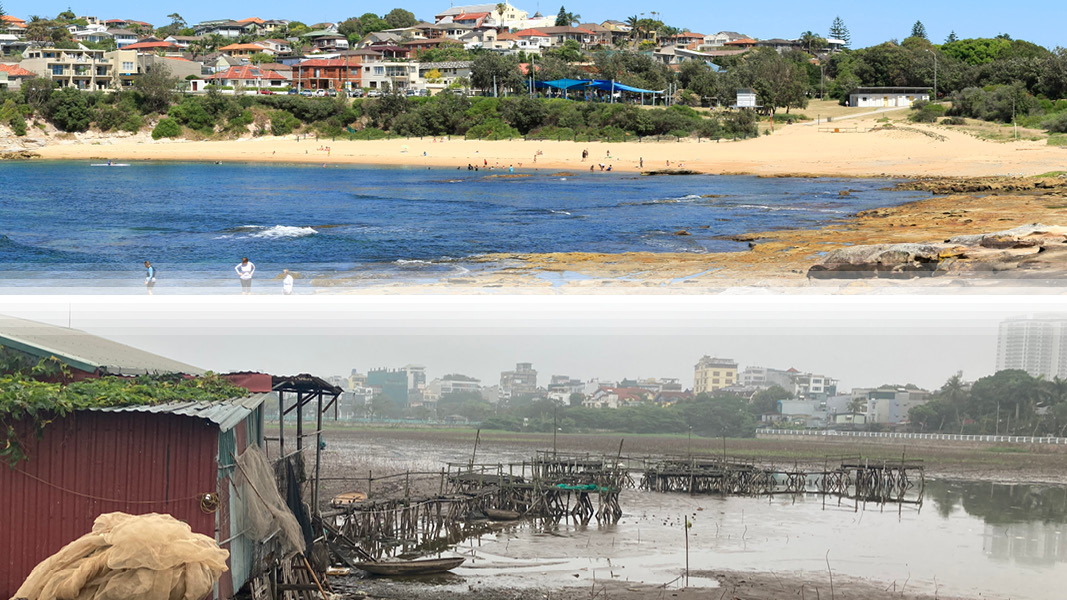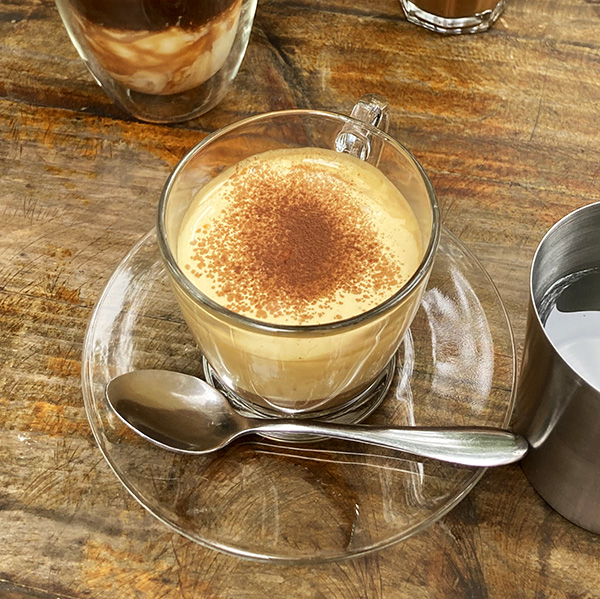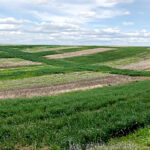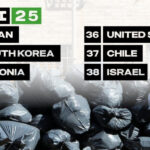Top: The beach at Malabar in Sydney, Australia (top) compared with a typical lake the author encountered in Hanoi, Vietnam (bottom). Photos by Adam.J.W.C., CC BY-SA 2.5 , via Wikimedia Commons (cropped and adjusted by BioCycle) and Sally Brown.
 Sally Brown
Sally Brown
I was recently invited to give the opening talk at the Australia/New Zealand biosolids conference that was held in Sydney, a lovely city that I’ve had the pleasure of visiting several times over the years. Because I’d spent time in Sydney and because it takes a day to get there, I decided that rather than extending my stay in Australia, I’d make a stop in Hanoi on the way. Granted Hanoi is not exactly on the way to Sydney, but it is a lot closer to Sydney than say if I’d gone via New York.
Hanoi and Sydney are both home to about 5 million people, give or take a 100,000. The economy in both countries is strong. While booming, Vietnam is still a developing nation with the per capita income in Hanoi of about US$6,000. In Australia, it is about 10 times that.
I’d been to Hanoi once before, yes again related to poop. That time was for the International Fecal Sludge conference. This time, I went to visit a dear friend and former graduate student who works for the State Department in the U.S. Embassy there. This is the end of her tour and so a wonderful chance to see the city through her eyes. Spending time in two cities within the same week was a study in exceptional contrasts. While you can get delicious coffee in both places (I tried egg coffee in Hanoi and opted for classic flat white in Sydney), the similarities basically end there.
A Stop In Hanoi
Hanoi is growing as quickly as possible with strong international investment and a developing industrial sector. Hanoi is also an environmental disaster unfolding in real time. For four of the five days I was there, the air quality made the top 10 list of the worst places in the world to try to breathe. The sky was a grey mist and nearby buildings (< 1 km or 0.6 miles) were difficult to make out. Pam said that on weekends, she tries to spend time indoors with the air filters going and the windows shut. In mornings after a rain, the windows and doors are opened wide, to let as fresh as it gets air into the house. Transportation is likely a contributor as most is by scooter. There is even an Uber equivalent for scooters where it comes with a driver, and you just get on behind.
Another culprit is solid waste burning. Pam lives in a relatively toney section of town with a lot of other expats and embassy folks. However, her home is a block or so from the major road into downtown. The strip alongside that road is home to open burning of household waste. She told me that once she witnessed a queen size mattress smoldering for several days. Pam separates her recyclables and I did see one woman on a bicycle collecting recyclables from a nearby house. However, this lone woman was a far cry from a municipal system.
We went to a place downtown famous for Pho, which was very good. As we were leaving, I saw two people on bicycles carrying plastic containers. They stopped to collect the extra soup, almost certainly to sell it or use for animal feed. As we walked around the city, it was impossible to miss the number of people dressed to the nines taking selfies in front of the many rivers and lakes. Here I would strongly recommend focusing on the face or the outfit. There is essentially no wastewater treatment in this city of 5 million. The lakes I saw all had floating fish, the result of functioning as effective sewers for the city.
I can understand the drive for growth in Hanoi. But the lack of infrastructure and the screaming need for regulation and investment brought me back to my first trip to this city. At the Fecal Sludge conference in 2015, I listened to local officials talk about how they might need to require and regulate wastewater treatment. Now might be a good time to start.
On To Sydney
Sydney was a welcome, different world. I actually drank water straight from the tap! I could see blue in the sky and my throat didn’t hurt at night. I took a train from the airport right into downtown. The biosolids folks were lovely and welcoming. Almost all of the biosolids in Australia are beneficially used. However, rather than this being a cause for celebration I kept hearing about the need for caution and how this was a time of great uncertainty. Relationships between regulators and generators is tense at best. Regulators in Australia apparently view municipal wastewater agencies as potential polluters rather than allies in the fight for a cleaner countryside.
At the meeting a panel of regulators took the stage and discussed potential limits for biosolids application based on, you guessed it, PFAS. Here the pathway of concern was identified as grazing dairy cattle, based on historically contaminated amendments applied to a farm halfway around the world. Now most of the biosolids program managers in the audience were laughing (or crying) about this as dairy cows make their own soil amendments. Why use biosolids when you can use dairy manure? Easier, and always available. The regulators here appear to be focused on protecting the highly unlikely potential occurrence rather than working toward a common good. Australia finds itself in a place right now where they have the luxury of saying “not here thank you.” They are luxuriating in a land of plenty rather than focusing on the potential for benefit.
The last day of the conference was a tour of the Malabar Wastewater Treatment plant, Sydney Waters’ largest. All of the biosolids from the plant are land applied with the majority going to farmland. As is always the case, the farmers love the stuff and there isn’t enough to go around. A portion is composted and used for gardens and landscapes. My host at the plant was kind enough to shoo me off to the neighboring beach so I could have a swim before heading to the airport. A far cry from Hanoi where swimming in the lake would land you in a hospital.
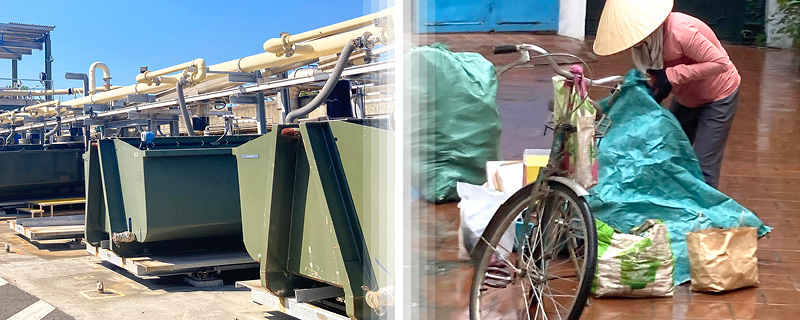
The advanced technology featured at a wastewater plant in Sydney, Australia (left) stands in stark contrast to a DIY recycler in Hanoi, Vietnam (right). Photos by Sally Brown
Vietnam is home to 97.5 million people, Australia to 25.7. Australia has always been a land of plenty including plenty of land for just a few people. Plenty is a new concept in Vietnam and they are working the little land they have to past capacity. Infrastructure investment and environmental regulations have the potential to clear the skies and clean the water in a relatively short time frame.
Just to get some perspective, I looked to see what the air quality was in Los Angeles. I remember back in the day the City of Angels was also known as the smog capital of the U.S. I found records back to 1980, after the Clean Air Act was put into place. In 1980, LA had six good air quality days and 159 very unhealthy or hazardous air quality days. Fast forward to 2021 and that had reversed to 41 good air quality and one very unhealthy or hazardous air quality days with most days (228) falling into the moderate category. Perhaps the next time I go to Hanoi, a fresh breeze will be blowing. Those selfies will look all that much better with a blue sky in the background.
Sally Brown, BioCycle Senior Adviser, is a Research Professor at the University of Washington in the College of the Environment.


